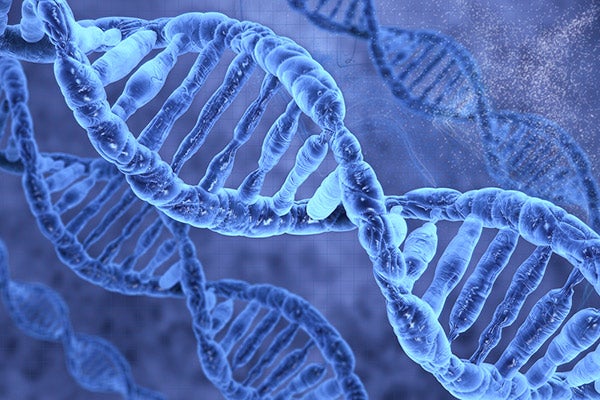|
March 14, 2014
Stanford scientists develop technique for observing behavior of single molecules in real time
The new technique allows scientists to observe single molecules of protein or DNA as they bind with other molecules, and could lead to better drug designs. By Bjorn Carey

Stanford researchers have developed a technique to observe single molecules of protein or DNA in real time. (Image: vitstudio/ Shutterstock) Nearly every biological or chemical reaction that makes life possible involves single molecules interacting in the watery solution that sloshes in and around cells.
Now, a Stanford chemistry professor and his graduate student have developed a technique for observing these processes as they happen in real time.
W.E. Moerner, a professor of chemistry, specializes in single molecule fluorescence, a field that involves studying how biomolecules – such as DNA and enzymes – work in cells to carry out the processes that are critical to life. The new advance describes how Moerner and his graduate student, Quan Wang, modified an ABEL (Anti-Brownian ELectrokinetic) trap, a machine invented in Moerner's lab that uses electric fields to manipulate individual small molecules from the light they emit, to isolate a single strand of DNA and observe how it binds to other DNA, in aqueous solution.
The work is detailed in the journal Nature Methods.
Getting this process started takes a little bit of luck, Wang said, as they must wait until a single molecule happens to be in the vicinity of the trap. This all happens at an incredibly tiny scale. The trap covers about a square centimeter, but the molecules are just 1 nanometer long. (For perspective, that's trapping a single grain of pollen on a football field, and then, without ever touching it, studying its behavior and characteristics.)
Once a lone molecule has entered the trap, its motion comes under continuous surveillance. Although the molecule doesn't want to sit still, every time it attempts to escape, the ABEL trap automatically applies electric fields to push it back.
Using physical analysis and computational tricks from machine learning, Wang developed an algorithm to convert the observed single-molecule motions inside the trap into information about the molecule's size and electric charge. From this, the researchers can determine whether the target molecule has interacted with another molecule.
In the case of DNA, if it begins to hybridize – that is, if it begins to bond to a complementary strand of DNA – the readings from the trap will show that the trapped DNA has an increase in both size and charge. When the process reverses a few instants later – that is, when the DNA melts and its complementary strand falls off – the trapped molecule's size and charge change back correspondingly.
"It is really quite amazing to be able to trap a single short piece of single-stranded DNA, to watch it for many seconds and directly observe a partner strand bind and unbind," Moerner said. "This is really an essential process."
The researchers conducted similar tests using proteins, and Wang said that the technology in its current state can easily be applied to many different types of molecules to study other binding processes.
"We've done the proof of concept for the method, and soon we want to apply it to two very specific problems and get some science out of it," said Wang, who is a graduate student in electrical engineering.
The first involves drug design. Drugs target diseases by binding to receptor molecules on cells, and the drug's effectiveness often depends on how well and for how long it binds to its receptor. By gauging the size and total charge of the molecules as they form a complex, the trap can directly measure how long it takes for the drug to find its receptor and how long the complex stays together. This information could guide scientists toward designing drugs that better match their target receptor.
Another application is to study the role protein aggregation plays in various diseases. As people age, proteins can become "sticky" and accumulate, a hallmark of several diseases, including Huntington's. The trap provides a direct way to study the size distribution of these proteins and how they aggregate; understanding this effect could lead to treatments that inhibit it.
Other students and postdoctoral scholars in Moerner's group are working to make the trap respond even more quickly, to perform more optimally in other situations, or to study different properties of single molecules. Moerner said that the interdisciplinary makeup of his group (including him; he holds a degree in electrical engineering as well as in chemistry) is critical for understanding all the different facets of this work, and then for smart implementation of it.
"We use light to probe molecules – that's physics and chemistry," Moerner said. "And we apply it to biology and biomedical systems. But at the core is precise measurement, extracting as much information as possible from a single object, and that can be done with concepts from electrical engineering.
"It's a natural thing at Stanford for students in one department to do thesis research in another. It's one of the wonderful aspects at Stanford, and it can lead to wonderful work such as this."
For more Stanford experts in chemistry, electrical engineering and other topics, visit Stanford Experts.
-30-
|